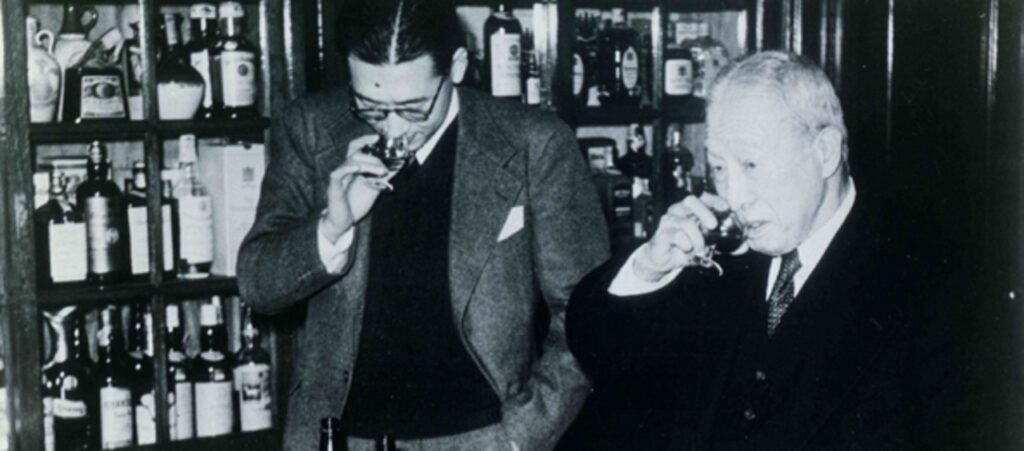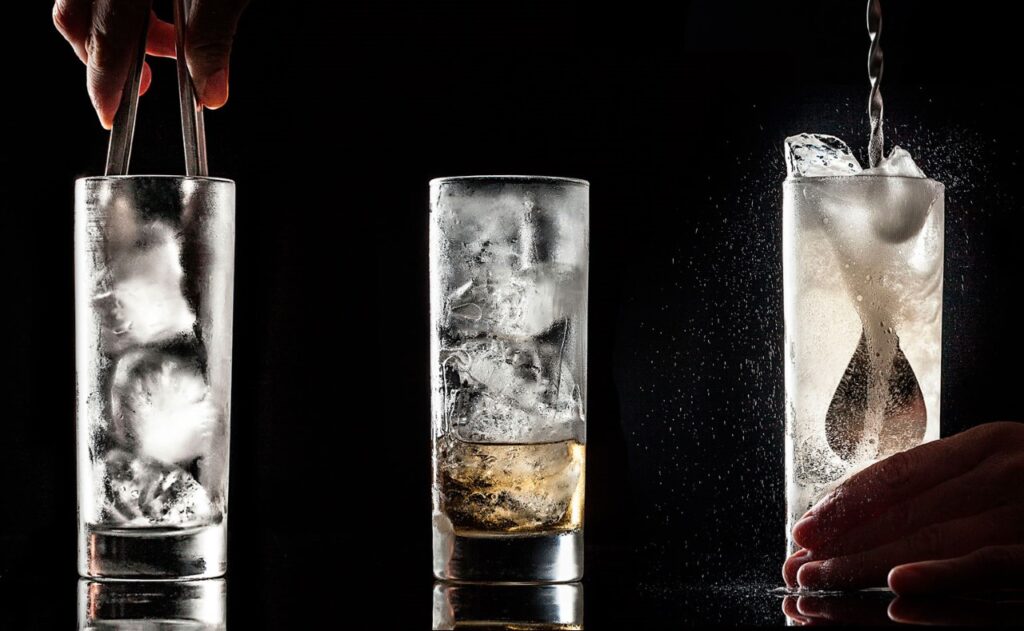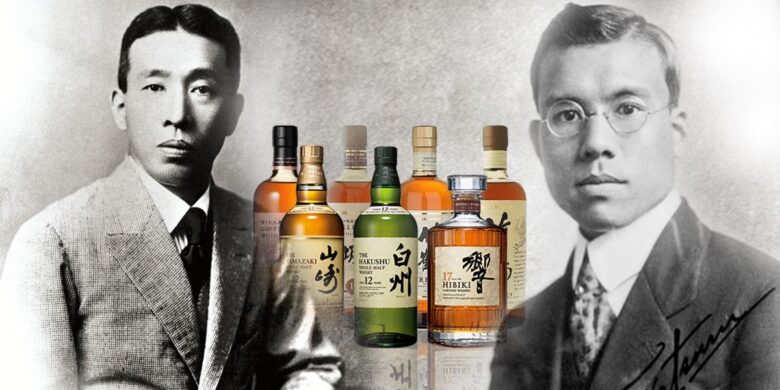Shinjiro Torii (left) and Masataka Taketsuru (right)
Whiskey, combined with a non-alcoholic carbonated mixer, served over ice in a tall glass is called a whiskey highball everywhere in the world. Except for Japan. In Japan, this is simply referred to as a Highball.
The origins of the term highball are grey. Some believe it has to do with the American Railway. Some believe it has to do with golf in Scotland. What is known is that the first direct mention of it is from an 1894 farcical comedy play “My Friend From India”, by Ha Du Souchet. A character named Erastus has the following line. “Talking about drinks, I think I’ll have one. (Enter Jennings) Jennings, bring me a high ball of whiskey.” The reference without explanation seems to infer that it as a well-used term by that time. In 1895, Cincinnati bartender Chris Lawlor includes the Whiskey High Ball in his book The Mixologist, and says of it, “Put in a thin ale glass one lump of ice; fill with a siphon seltzer to within an inch of the top, then float one jigger of brandy or whiskey.” By 1900, Harry Johnson’s influential Bartenders Manual gives the drink the name Highball for the first time, and it is the drink we think of today.
It would appear that despite the railroad explanation by alcohol writer and historian Gary ‘gaz’ Reagan in his 2003 book The Joy of Mixology, this story may not be accurate. It does seem plausible, however, as a railroad engineer would check the float on the engine water tank before proceeding. If everything looked good, the engineer would give everyone the sign to proceed – two short whistle blows followed by one long whistle, indicating that the float ball was at the top of the tank. This whistle sign was referred to as the ‘highball’. This correlated to the two shots of whiskey followed by a long pour of soda water in the drink (and the added story that conductors would have a whiskey and soda while waiting for the tank to be filled with water).
But for my money, the Scottish explanation seems more plausible. A ‘ball’ was a term used historically for a glass of whiskey in Ireland served neat, and later on the golf course throughout Great Briton. Therefore – a ‘high ball’ was the same drink in a tall glass with carbonated water added. This also seems to tie in with our comedy play referred to earlier, when Erastus asks for a high ball of whisky.
Whisky distillation began in Japan as early as 1870, but for all intents and purposes, its birth was in 1923 with the opening of the Yamazaki distillery in Shimamota, Osaka. The Japanese whisky from the start echoes the traditional whiskies of Scotland (The term ‘whiskey’ is used in the Unites States and Ireland – but in Japan it is referred to as ‘whisky’ in deference to its Scottish lineage). It all springs from the passion of two men, Masataka Taketsuru and Shinjiro Torii. Taketsuru is referred to as the ‘father of Japanese whisky.’ He studied distillation in Scotland for three years, learning everything he could about the craft. He returned to Japan with his Scottish wife and set up the Yamazaki Distillery for Shinjiro Torii, and later left to open the Nikka Whisky company. Torii was the founder of Suntory Whisky, known as Kotobukiya, and built the Yamazaki distillery in 1923. After mixed success in finding a whisky that aligned with the taste profile of the Japanese, Torii released Suntory Kakubin from the Kotobukiya distillery, and it was a huge success – and is still the most popular selling whisky in Japan.

But the Japanese didn’t just settle for copying another country’s whisky production. In 1853, American Naval Commander Commodore Matthew Perry sailed into Edo Bay with a squadron of powerful vessels and overpowered the primitive Japanese military. They soon entered a period of modernization to catch up with the, until that time, unknown civilizations of the West. And when Japan modernized, they adopted a motto; Wakon Yosai, or in English “Western technology, Japanese spirit.” It was the goal of the Japanese to learn from others in the West, but then better them at their own game. This was adopted in all forms of industrialization and is true of the production of whisky as well. In true Wakon Yosai fashion, the Japanese adopted whisky as a sign of a modern society. Adoption, though, was only their starting place. They continued to elevate the production of the spirit and lifted the construction of the cocktail to an art form.
For a country with a long history of making and drinking sake (thought to go back 2,500 years in Japan, when rice began to be cultivated on a large scale), they embraced the new Japanese whisky quickly. The common story is that whisky became very popular as a before dinner drink at dinner parties, served neat. But whisky neat is not a dining beverage, so they turned to the whisky highball – one of the reasons the Japanese have crafted their whisky to be paired with food. The Highball really took off in the 1950s. With their country decimated from WWII, and few with money to spare, the highball became an affordable way to drink. Suntory, in an effort to capture the market, began building highball bars across Japan. By the mid-50s, the highball had entered its boom phase. The boom was short lived however, and by the 1980s the Highball was considered an old man’s drink (like classic cocktails in general in the US at the time). Japan was suffering through a depression, and good whisky was expensive – so drinkers increasingly turned to beer or shōchū.

Japanese whisky today is in the middle of a renaissance. Their distillation, copied from – then improved upon – the Scottish tradition, has been winning international awards, often times besting Scotch in international competitions. Since the turn of the last century, Suntory has been promoting their whisky to younger audiences, trying to cast off the old man image. You may remember the premise of the 2003 movie Lost in Translation where Bill Murray’s character is hired by Suntory to promote their Hibiki-17 whisky in Japan.
‘So what are you doing here?’
‘Couple of things. Taking a break from my wife, forgetting my son’s birthday and, uh, getting paid two million dollars to endorse a whisky when I could be doing a play somewhere… But the good news is the whisky works.’

The film created explosive growth for the Hibiki-17 (hibiki means ‘harmony’ in Japanese), a real product marketed within a movie. In 2008 the Yoichi 20 year old whisky, produced by the Nikka Whisky, was named the best single malt at the World Whiskies Award. Then in 2015, whisky expert Jim Murray awarded a record-equaling 97.5 marks out of 100 to Suntory’s Yamazaki Single Malt Sherry Cask 2013, hailing it as “near indescribable genius.” It was awarded the title of the World’s Best Whisky of 2015, causing a more than a few Scots to shed a tear or two.

The Highball constructed in Japan is part tradition, and part ritual. It takes its cues from the formality of the traditional Japanese Tea Ceremony. Obviously, one cannot make a true Japanese Highball with anything other than the highest quality ingredients, and it is made with a zen-like focus to detail. One must start with clear, block ice, carved into perfect cubes, leaving only room for a bar spoon between the ice and the glass. The carved ice is placed in a high quality highball glass and stirred until the surface begins to frost. Any excess water is poured out and then the whisky is added carefully between the ice end the glass – never touching the top of the ice. The ice and whisky are stirred exactly 13 times clockwise to chill the spirit. The soda water is then added between the ice and the inner surface of the glass to within 1/4 inch of the top of the glass – again never touching the top of the ice. It is the stirred exactly 3 times counterclockwise to mix, then served.
Does this result in a better whisky highball? Is a Guinness better when the double pour takes exactly 119.53 seconds? Maybe. Or maybe it’s like smelling a hamburger on the grill or planning a vacation for months – it’s about the anticipation. I know I enjoy it more when the rituals are followed. It places the cocktail in a mixology continuum that makes it greater than the single drink in front of you. It introduces you to the sublime.
Cheers!
Bill
Instagram@architecture_of_the_cocktail
Previously in Architecture of the Cocktail:
Architecture of the Cocktail: Ten Things You Probably Didn’t Know About Bourbon, by Bill Stott
Architecture of the Cocktail: The True Story of Jack Daniel’s Whiskey, by Bill Stott
Architecture of the Cocktail: World Whisky Day. A Brief History of Whisk(e)y?, by Bill Stott
Architecture of the Cocktail: The Japanese Whisky and the Highball, by Bill Stott
Architecture of the Cocktail: The Delicious Dozen, by Bill Stott
Architecture of the Cocktail: What makes a cocktail, a cocktail? by Bill Stott



